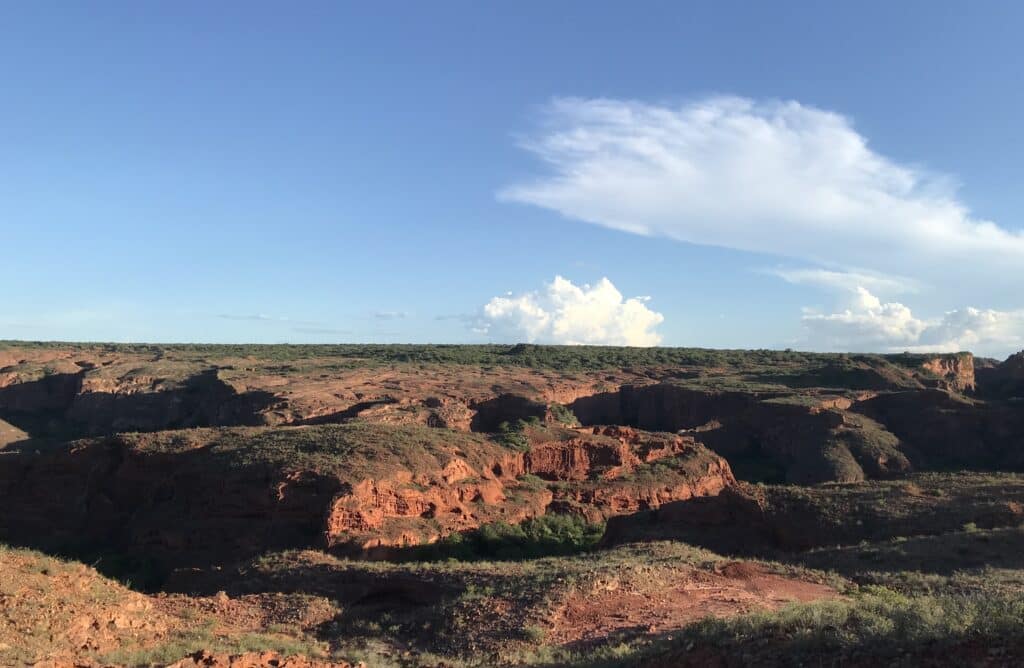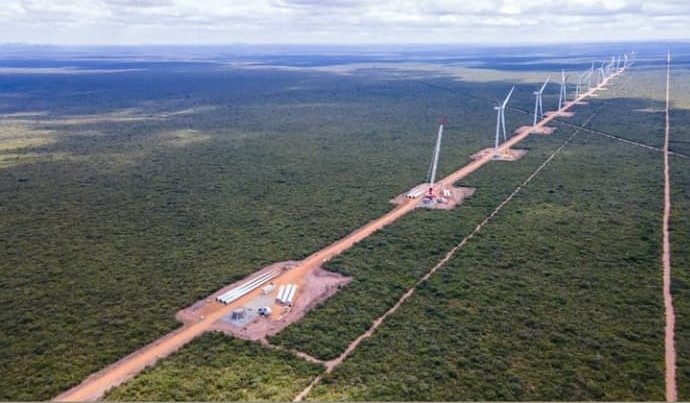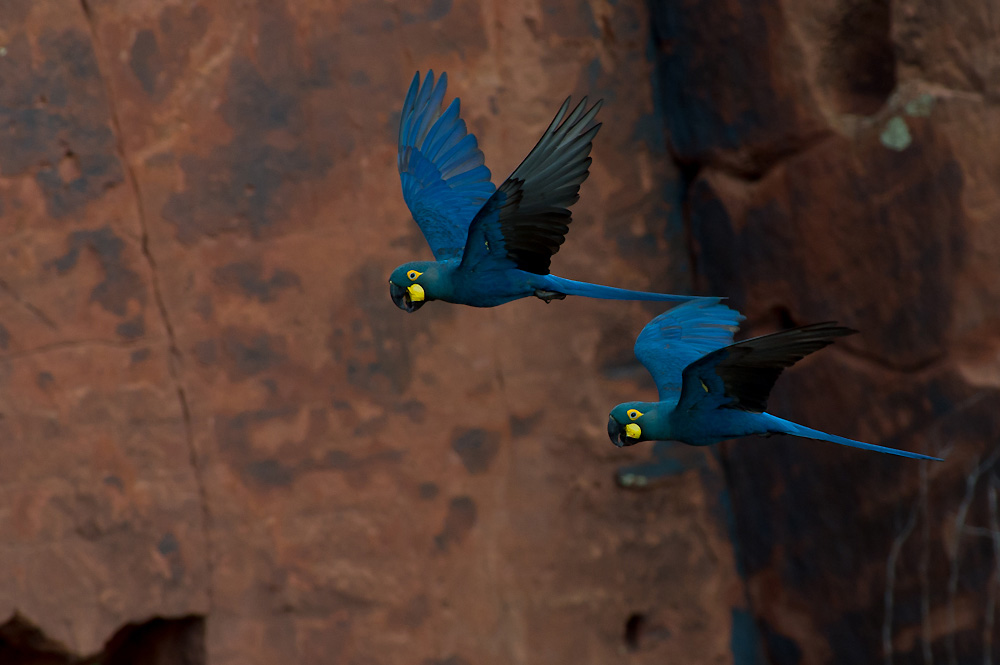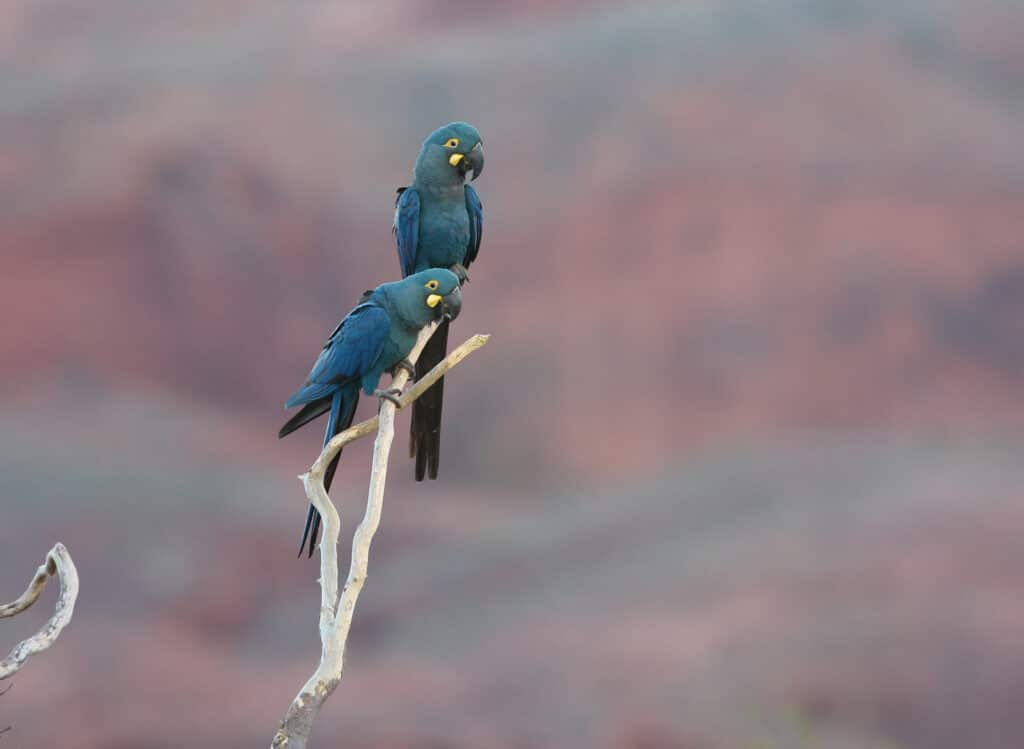A new wind facility threatens to derail one of conservation’s success stories
As few as 60 wild Lear’s Macaws remained in the 1980’s but following years of conservation efforts the species’ population has recovered remarkably. Worryingly, the French company Voltalia have begun building a wind facility within the Lear’s Macaws tiny range, threatening to jeopardise these extraordinary conservation gains.
Endemic to the dry Caatinga forests of Bahia state in north-eastern Brazil, Lear’s Macaws nest in burrows within the sandstone cliffs dotted throughout the landscape. Although first described in 1856 from an illustration by the poet Edward Lear, and known from a handful of parrots found in trade throughout the 19th and 20th century, the first wild Lear’s Macaws were only discovered in 1978. However, upon their discovery, surveys soon revealed a species on the brink of extinction, with habitat loss, hunting and trafficking for the pet trade leaving the global population of Lear’s Macaw as few as 60 birds by the 1980s.
Conservationists quickly got to work, undertaking intensive conservation efforts, which included engaging local communities to stop trade and habitat clearance, as well as establishing and bolstering the protection of the Canudos Biological Station – a privately run reserve where most of the world’s Lear’s Macaws roost, which is supported by American Bird Conservancy (ABC, Birdlife USA) and managed by ABC’s Brazilian partner the Biodiversitas Foundation.
These efforts led to a remarkable recovery of the species, and there are now close to 2000 Lear’s Macaws occurring in Bahia, this increase recognised by the species’ downlisting to Endangered in 2011. However, its extremely limited distribution makes this recovery precarious, and a new wind farm being built by the French company Voltalia threatens to jeopardise these extraordinary conservation gains.
Granted a licence by the State Environmental Agency in 2020, the project is in the Canudos region of Bahia State – a Key Biodiversity Area (KBA) and an Alliance for a Zero Extinction (AZE) site given it is home to the entire global population of wild Lear’s Macaws. In early 2021, Voltalia cleared land to make way for the wind farm and recent images have shown the first turbines are now installed. This is despite the fact that the Public Ministry of the state of Bahia recommended the project be suspended in July 2021.
“The increase in the population of Lear’s Macaw in recent years is an example of a successful conservation story resulting from a collective effort by NGOs, government and the local community.” says Pedro Develey, Director of SAVE Brasil (BirdLife Brazil). “The installation of a wind farm project in the species’ small distribution disrupts these conservation gains”. The fact the wind farm overlaps with an AZE also directly contradicts Voltalia’s own sustainability commitments to meeting the International Finance Corporation’s performance standards on environmental and social sustainability.
While Voltalia did conduct a small impact assessment – as well as proposing certain mitigation measures within the facility– a full Environmental Impact Assessment will only be conducted once the facility is in operation. This is concerning, as Lear’s Macaws have multiple characteristics that often make species vulnerable to wind farms: they are large-bodied and highly mobile, often flying up to 70km at high speeds in search of food, usually during the dimly lit hours of dawn and dusk, making collisions more likely. “In my opinion, I don’t think the site where the Canudos Wind Farm is being implemented is adequate because it’s in the centre of the species’ route to their main roosting and feeding areas,” states Lorinho Reis, a birdwatching guide in Canudos. “I believe the wind turbines, as well as the electricity lines, will offer a high risk of collision and electric shock to flying animals, especially the macaws that fly in flocks, meaning a single incident could kill several individuals.”
Conservationists are already working hard to conserve the species from several persistent threats, notably the capturing of hatchlings to supply the illegal pet trade, collisions with powerlines and the lack of growth of the Licuri Palm, their main food source. Adding collisions with wind turbines to this list of threats may be enough to curtail the recent population recoveries, particularly given the species is long-lived and therefore highly sensitive to increased adult death rates.
By Liam Hughes
Header Image: A pair of Lear’s Macaw’s flying over the Caatinga forest © Fábio de Paina Nunes



Renewable energy should not compromise biodiversity
On behalf of the KBA partnership, BirdLife, alongside other conservation organisations, including SAVE Brasil, ABC and LPO (BirdLife France), have written to Voltalia, urging the corporation relocate the Canudos wind facility, as well as restoring the vegetation they’ve already cleared. Since 2020, SAVE Brasil and ABC have also frequently offered to cooperate and help identify more suitable sites, although the French corporation has been reluctant to engage. “Even with the mitigation measures proposed by the company, the risk of macaws dying is real, which would justify the installation of the project outside the species’ range.” says Develey. “They should have looked for other alternatives!”
It’s not just conservation organisations that have campaigned against the facility – in 2021, 70 traditional communities in Bahia also signed a letter against the development, highlighting how it will negatively impact local livelihoods, such as through restricting access to traditional grazing lands, as well as the lack of public consultation during project planning. The communities also outlined their concerns for biodiversity, and particularly for Lear’s Macaw, given they have become a symbolic species to the region and now attract tourists from across the world, hoping to glimpse the elusive bright blue macaws.
The outcry from BirdLife and our partners against Voltalia’s developments are by no means a criticism of all sustainable development projects in the region. Transitioning from fossil fuels to renewable energy sources is critical to stopping climate change, and these projects can also contribute significantly to local economies. Indeed, BirdLife have worked alongside several energy companies to minimise the biodiversity impacts of their facilities. However, not all sites are suitable for wind farms, and Voltalia’s decision to proceed with a wind farm in the vicinity of such a crucial population of an Endangered species is reckless.
The emerging nature of the renewable energy industry also offers the unique opportunity for plans to be proactive in minimising their impacts on nature, unlike so many of humanity’s activities that we are still retroactively battling to mitigate the effects of. It is feared, however, that Voltalia’s commencement of this project may set a worrying precedent for other development projects in the region to proceed with minimal considerations of their biodiversity impacts – Voltalia itself has already proposed 12 additional sites for development within Bahia. The project may also tarnish the reputation of other renewable energy companies that have behaved responsibly, meticulously ensuring their projects have limited impacts on wildlife.

“Even with the mitigation measures proposed by the company, the risk of macaws dying is real, which would justify the installation of the project outside the species’ range. They should have looked for alternatives!”Pedro Develey, Director of SAVE Brasil
Hope for Spix’s Macaw
There is better news for the Spix’s Macaw, another species endemic to the Caatinga forests of Bahia state until it was declared Extinct in the Wild in 2019 – although the last known wild bird had disappeared over 20 years ago. Following decades of research and planning, a reintroduction programme for the species began in June this year, when eight captive-bred macaws were released into Curaçá, another KBA and AZE in Bahia. However, Voltalia had proposed another wind farm in the vicinity of the AZE site, which given Spix’s Macaw often fly up to 50km in search of food, would have been a considerable threat to what is already a precarious situation.
Fortunately, in this instance the corporation has seemingly deemed the conservation costs too high – whilst perhaps also wary of a media backlash – and the proposed project has been scrapped. While there is still a long way to go until Spix’s Macaw can officially be declared to have returned to the wild – the reintroduction programme itself will continue for 20 years – the cancellation of this wind farm has increased the chances of a remarkable successful return to the wild for the species.



